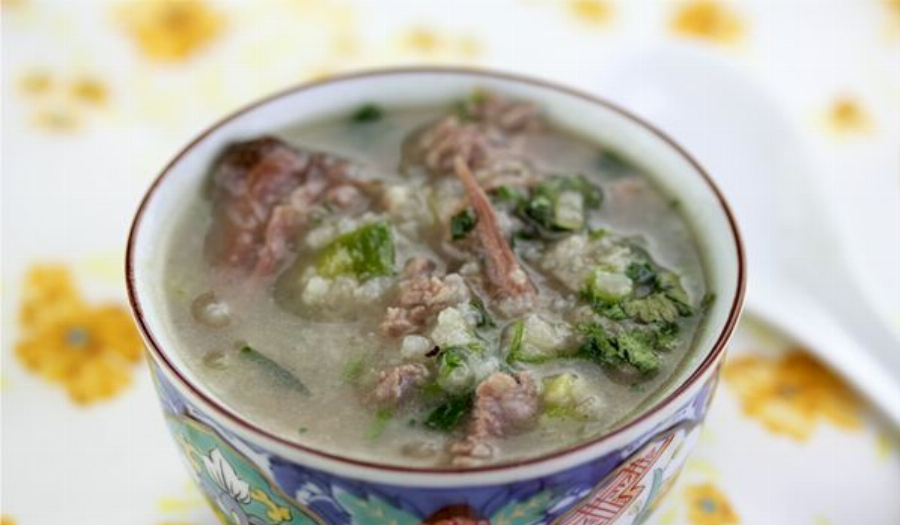Cháo, or rice congee, is synonymous to me with cold remedies. As a child, this Vietnamese soup was Maman’s antidote; the warmth is soothing for the throat and the soft texture makes it easy to consume. The soup contains a handful of rice which acts as a thickener for the flavorful broth. Today, I made my favorite version: it’s called cháo thịt bò, “beef rice soup” in Vietnamese.
I made my usual beef broth in the same manner as I would to prepare phở bò. I added oxtail bones, ginger and onions. My trick for never messing up this recipe is to cook the rice in small portions. I cook 3 cups of broth for a few tablespoons of rice. You’ll get a much better product if you prepare it in small batches. As soon as the rice thickens the beef broth, I add paper-thin slices of flank steak at the last minute along with fresh ginger and freshly cracked pepper.
1. Info for Chao Thit Bo Recipe (Vietnamese Beef Rice Soup)
- Cook Time: unavailable
- Total Time: unavailable
- Servings: 8
- Calories: 432
2. Ingredients for Chao Thit Bo Recipe (Vietnamese Beef Rice Soup)
- 6-¼ to 6-½ quarts water
- 1 dozen beef knuckle bones (the more, the sweeter the broth will be)
- 1 dozen oxtail bones
- 1 yellow onion, peeled
- 1 (6-inch) chunk fresh ginger
- 2 carrots, trimmed and peeled
- 2 daikon radishes, trimmed and peeled
- 2 tablespoons canola oil
- 3 cloves garlic, finely minced
- 2 shallots, thinly sliced
- 7 tablespoons kosher salt
- 1 chunk rock sugar (about 2 ounces) or (3 tablespoons granulated sugar), to taste
- 2 cups broken rice (see tips)
- 1-½ pounds “outside” flank steak (or filet mignon), very cold
- 3 tablespoons cilantro, finely chopped
- 3 tablespoons green onions, chopped
- 1-½ teaspoons black pepper, freshly cracked
3. Directions:
- Wash the whole unpeeled ginger and remove any dirt; pat dry. Cut about 2 inches of the ginger root. Peel the small piece with a paring knife, thinly slice it, then cut into long matchsticks. Set aside.
- Bruise the rest of the ginger using a mallet to loosen the flesh and help release its flavor.
- The day before… In a pot, soak the beef bones in about a quart of water with 1 tablespoon of salt (overnight preferably). The next day, rinse the bones, place them in a pot and cover with water. Bring to a boil and cook for 5 minutes. Drain the water. Rinse the bones under running water and set aside. This step is important to get clear broth before starting the long, slow cooking. Fill a 12-quart stockpot with 6-¼ quarts of water. Bring to a boil. Add the beef bones, oxtail bones, bruised ginger, fresh daikon, carrots and the whole yellow onion. Bring the liquid back to a gentle boil, then lower the heat to a bubbly simmer. Cook for 1-½ to 2 hours. Using a fine mesh strainer, regularly skim the impurities rising to the surface of the broth. Once the broth is cleared of any impurities, add salt and rock sugar. Bring to a roaring boil for about 30 minutes and cook until the broth is reduced by 1/3.
- Check the seasoning. Season with more salt (if necessary) and pepper. Adjust the sweetness of the broth. The amount of sugar varies with the amount of beef bones and vegetables.
- Remove the beef bones, cover with cold water and set aside for about 15 minutes. (Note: The method used to ensure that the meat does not darken as the broth cools down is basically the same procedure as that used to keep vegetables a bright green color). Drain the water from the beef bones and refrigerate them until it’s time to serve.
- Let the broth come back to a boil for a last time, then remove the pot from the stove. The broth is ready!
- If you’re health conscious, you can remove the fat from the broth: Let the broth cool down to room temperature, plastic wrap the pot tightly and place the whole pot in the refrigerator until you’re ready to serve. The fat from the broth may pick up some other odors from the refrigerator if the container is not sealed properly. A layer of fat will form at the surface; it can be removed using a large spoon. You can skip this step by using a fine mesh strainer and regularly degreasing as the broth cooks.
- You can ask your butcher to thinly slice it for you. My local Asian store provides this service. Just mention you need flank steak for phở bò; that way you’ll get paper-thin slices.
- Your other option is to place the whole piece of meat in the freezer for about 30 minutes. Then thinly slice the meat using a sharp chef’s knife. Make sure to cut the meat perpendicular to the grain so the slices remain tender.
- Note: The key to a successful outcome is to prepare the bowls individually (no more than 2 servings at a time).
- Wash and rinse the broken rice thoroughly in several water baths. Unlike basmati rice, no soaking time is needed. Drain as much water as possible.
- Heat the oil in a non-stick, medium saucepan. Add thinly sliced shallots. Cook over medium-low heat for about 10-15 minutes, stirring frequently to prevent the shallots from burning, until the color is evenly golden brown. Transfer the shallots to a plate, leaving about 2 teaspoons in the saucepan.
- Add ½ cup rice to the saucepan. The oil should coat all the grains. Add 2 cups of boiling-hot beef broth and stir occasionally. Bring the liquid back to a boil, then immediately lower the heat to a gentle boil. Cook until the broth thickens like porridge. Add one reserved oxtail bone and a few ginger matchsticks. Depending on the consistency you like, you could add more beef broth to thin out the soup. Adjust seasoning.
- Add the green onions and cilantro to the saucepan. Bring to a full boil one more time, then add about 3 tablespoons of the sliced raw flank steak. As soon as the beef slices are in the broth, transfer the beef rice soup (cháo thịt bò) immediately to 2 individual serving bowls so that the meat keeps a slightly pink color and remains tender (the meat will finish cooking from the heat of the soup).
- Garnish with the reserved caramelized shallots, more cilantro and a sprinkle of freshly cracked pepper.
- Serve immediately. You could drizzle the top with a little nước mắm (fish sauce) if you like.
- Repeat the same procedure for the next servings.

